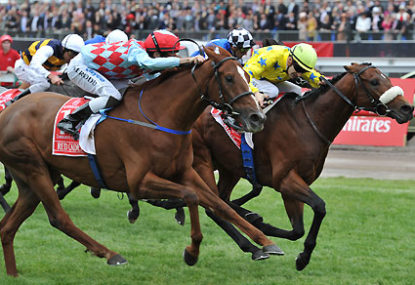TWO GOOD! Zahra wins back-to-back Melbourne Cups on Without a Fight as three horses pull up lame
Without a Fight completed the rare Caulfield Cup-Melbourne Cup double on Tuesday as star jockey Mark Zahra went back-to-back in the big one after…

There has recently been a drastic increase of horses imported to Australia. It has now extended beyond the cashed up metropolitan stables, and smaller stables appear to have given up on training local talent.
Just about everyone in the Australian racing industry has acknowledge the lack of talent among local stayers. Australian racing is clearly in favour of sprint racing and it is having economic effects on the industry.
This can be witnessed most prominently from the operations of breeders and administrators, which ultimately influence the actions of owners.
Australia’s most prestigious race, The Melbourne Cup, has prompted fierce debate over the past three years with the dominance of the imports and the raiders.
Imports are those that are purchased from overseas (mostly Europe) and assigned to their new Australian trainers on a permanent basis. The raiders are those trained overseas and come to Australia solely to take the Melbourne Cup back to their home country.
Concerns have been growing since the French raided back-to-back Melbourne Cups with Americain in 2010 and Dunaden in 2011.
While Australia restored some form of resistance in 2012, when locally owned Green Moon claimed the Cup, he was bred in Ireland and raced his first two season in England. He was then purchased by Lloyd Williams in 2011 and relocated to Melbourne.
If we were to scan our eyes over the field of 24 Melbourne Cup runners last year, the dearth of locally bred talent is mystifying.
Just two of the horses (Niwot and Ethiopia) were bred in Australia. If we widen our search slightly, four more were bred in New Zealand.
Of the remaining 18, ten were imports and eight were raiders.
Lloyd Williams is one of Australia’s most prominent owners and the Melbourne Cup is just about the only race on the calendar he has any interest in winning. However, based on his recent purchases, he appears to have given up on local purchases.
His decision to purchase lightly raced stayers from Europe has had excellent returns and over the past two years, trainers from all over the country have followed.
Leading Sydney trainer Chris Waller is quickly establishing himself as the leading trainer of imports. Most of his best horses these days are imports.
Having claimed Group 1 victories beyond 2000m this season with Reliable Man, Foreteller and Beaten Up, it’s a strategy smaller stables are now exploring.
The larger stables tend to be filled with cashed up owners who can diversify their racing portfolios between local and imported investments.
Perhaps it’s a sign of things to come when trainers like Tony McEvoy and Sam Kavanagh are now achieving greater metropolitan success with their imports rather than their locals.
The economical reasoning for importing horses cannot be flawed.
Australian racing is administered in a way to focus on sprinters. It leads mares with good racing blood to be sent to sprinting sires. Slowly, the quality of those sired by staying stallions decreases and Australian racing is flooded with sprinters.
Meanwhile, in Europe, there is a much greater concentration on staying races. Because there are many more quality races beyond 2000m when compared to Australia, there is a much greater supply of decent stayers.
It’s been proven that Group 2 stayers in Europe are consistently better than Australian Group 1 stayers. Caulfield Cup and Melbourne Cup winner Dunaden has never actually won a European Group 1 but comfortably achieved Group 1 success in Australia and Hong Kong.
With an abundance of staying talent in Europe, they are priced very moderately. 2013 Melbourne Cup favourite Puissance de Lune was purchased for 90,000 Euros ($120,000 AUD) from France.
The stayer has already won double that in prize money since racing in Australia. The previous owners will be filthy if Puissance de Lune wins the $6.2million Melbourne Cup!
The number of imports within Australian stables is drastically increasing. Because it works out economically and they are proving to be much safer investments, there is nothing to suggest importing will stop in the near future due no trade barriers in place.
Perhaps a quota system could be considered. It would prompt owners redirect their investment into local talent and consequently encourage breeders to produce stayers.
The absence of local staying talent is an obvious problem but if current trends continue, the ranks will be filled exclusively with imported talent.
They solve our problem by increasing the quality of our races but dependence on another country as an export source doesn’t quite sit right.
Should we be concerned or just exploit Europe’s sources?